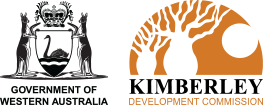Primary Industries
Invest in the Kimberley
Discover more about investment opportunities within the Kimberley.
Primary Industries

The Kimberley has an abundance of the key natural resources necessary for a strong agriculture and food industry: climate, soil and water. As such, agriculture is already one of the Kimberley’s most progressive, vibrant and promising industries. The industry has large potential for future growth:
- It has excess capacity;
- Additional scope for development; and
- Has already succeeded in attracting large-scale foreign investment.
The Ord River Agricultural Area (ORIA)
In the East Kimberley, the Ord River Irrigation Area is the State’s largest irrigated agricultural project and has been developed in two stages:
- Stage 1 in the 1960’s and 1970’s saw construction of the major water supply and drainage infrastructure and 14,000 ha of agricultural land.
- Stage 2 (Ord Irrigation Expansion Project) from 2009-2013 involved State Government funding of $311 million through Royalties for Regions to release 13,400 ha of agricultural land and supporting infrastructure.
The Ord Valley produces a wide range of grains and seeds including sunflower, safflower, maize, grain sorghum, chickpeas, soybean and a wide variety of hybrid seed crops. Further, Sandalwood harvesting has been conducted in small stages over the last years. Sandalwood plantings are predominantly managed by Quintis with smaller areas owned and managed by Santanol and private owners. Production is around 300 tonnes per year.
Cotton is an emerging industry in the agricultural sector. Farmers in the valley believe that cotton could be the base crop they had been looking for since the mid-2000s.
Kimberley Agricultural Investments (KAI), the developers of the ORIA Stage 2 expansion, have planted around 2500 ha of mixed grain crops (chia, sorghum and millet). No detailed production data is available, however it is estimated that production targets are around 1.5 tonnes per hectare and gross return of $3,000 – $3,500 per hectare.

In the West Kimberley, the introduction of intensive centre pivot and taped irrigated systems has enabled the expansion of fruit and vegetable cropping into the area. There are a number of enterprises already taking advantage of the extensive groundwater resources, with further opportunities to develop in this area.
Pastoral
The Kimberley currently has over 90 pastoral leases, of which it is estimated that at least 30 are beneath peak production. There is an opportunity to improve through better land management, breeding genetics, better fodder and improved livestock performance, using models established in similar northern Australia operations.
The improved market position for beef cattle exports has seen a resurgence of fodder production and feed supplementation. High levels of interest are being generated from recent major investment in the pastoral industry from new players such as Hancock Agriculture and others.
Water for Food
The Kimberley’s surface water resources are significantly more than the entire rest of the State but are less than 70% allocated. The greatest volumes are carried by the two largest rivers – the Fitzroy River in the West Kimberley and the Ord River in the East Kimberley. The Region’s major groundwater resources occur in the sedimentary Canning Basin, with other resources in smaller sedimentary basins and more distributed alluvial and fractured rock aquifers.
Tapping into the region’s potential, the Water for Food initiative is a four-year $40 million Royalties for Regions funded State Government program aimed at increasing economic growth and regional employment.
The program will use water source discoveries to develop new irrigation areas and increase the size and productivity of existing irrigation districts.
To find out more information on specific projects please see the Department of Water’s Water for Food page.
Fishing and Aquaculture
The Kimberley is the regional leader of Western Australian aquaculture production with pearling and cage farming of barramundi dominant. With the many bays and strong tidal flows in the Kimberley, there are many suitable sites and opportunities to develop or support other key species. The Aquaculture Park near the port is tenanted by North Regional TAFE and Aqua Broome and has significant capacity to expand diversity of operations and output from this facility. Barramundi are farmed in Cone Bay (100km from Derby) by Marine Produce Australia.
There are many opportunities to build on the industry within the region and a number of large projects that will significantly increase regional product are underway. In 2016, the Commission hosted a State wide aquaculture forum where these opportunities were discussed by key industry stakeholders and government. A Brochure summarising forum topics on Kimberley Aquaculture is also available under our Publications section.
For more information on the Status of the current fishing and aquaculture industries in the Kimberley and Western Australia please see the latest West Australian Department of Primary Industries and Regional Development (Fisheries)
Useful Links

Invest In the Kimberley
The Kimberley boasts many progressive, vibrant and promising industries with large potential for future growth.

Annual Report
Ensuring the transparency and accountability for the Kimberley Development Commission.

Our Region
The Kimberley is a complex landscape that represents one sixth of Western Australia’s land mass; equivalent to twice the size of Victoria.

Local Content
Our Local Content Advisor will help develop, promote and maximise opportunities in the regions.
